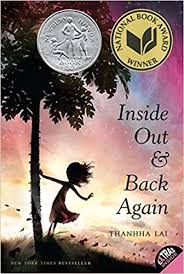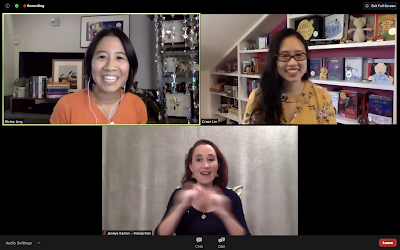I just finished practicing my Beyonce dance breaks as I get ready for a visit with Jason Reynolds, Nic Stone, and Caitlyn Dlouhy. I laid out the regulars. Four of his books that I love, a copy of DEAR MARTIN written by Nic Stone, and a sandwich. There is a contest going on at the house. If Jason mentions some of his title, I have to stand and do a Beyonce dance break. I have been practicing all weekend. What would make my day is if Jason doesn't mention his work. But that wouldn't be fun since more than five thousand SCBWI members are tuned in. It is past 2:30 and I'm sitting here, pen, paper, ZOOM waiting room, and Beyonce on pause.
Nic Stone enters. Her face glowing, smile big and bright as if she was auditioning for a toothpaste commercial, pure #BlackGirlMagic radiating through the computer screen. She briefs us, the five thousand members glued to the screen waiting to take notes as we listen to the winning formulas from Jason Reynolds, The National Ambassador of Young People’s Literature and award-winning writer.
Nic introduces CAITLYN DLOUHY and JASON REYNOLDS. Nic informs us she will be discussing craft with Jason and immediately grabbed two pens and a bigger notebook. "You were really something," she said to Jason. WHEN I WAS THE GREATEST by Reynolds captivated her. She loved the voice in his work. She asked him about writing “voice” in his novel and how he does it so well. "It is a hard thing to pin down," Jason responded. Jason wants to be in an authentic place when he writes. But how do you write an authentic story? According to Reynolds, “Be an authentic person. Create a protagonist and spend time with them. Get to know them. Put them in an environment with challenges.”
Yes, Nic. It is difficult for writers to find their voice when they write. Jason states that in his career he has been "shooting from the hip." He continued to say, "I'm just doing the thing that seem right for me." Reynolds strategy is to build his character through the people in their lives. This is deep! Jason is like me a PANTSER! However, he admits, sometimes he might outline a little, but barely.
When asked what her preference is, Nic says, “I’m an outliner.” She starts with a character template filled out for the character in detail. In which, Jason interrupted to let her know he hates doing the double work of writing to write again. I’m dead. "I wish I had the discipline and developed the muscle to be an outliner," Jason said. Me too, Jason! Me too!
Jason's mother was a smart woman who told him, "Nobody remembers a bad review. Everyone remembers a bad response." I love Mamas. This is so true.
One of the things that stood out to me was when Jason said, “I don’t take myself seriously. I do take my work seriously. I always tap into the child in me.” As a children’s writer, this is so important. To think back to when you were a child. Time have changed, but kids are kids. There are developmental mile stones that are synonymous across the board for many children. I felt that.
Jason stared into the camera. “‘People say writing is who I am.’ No writing is what I do.” And in that moment, that brief moment, he mentioned the late Whitney Houston who was deemed and labelled, “The Voice.” This was an aha moment for me. Jason noted that when Whitney’s voice started to go, her life started to jump off the rails as well. How profound. This is why writing will not define him. “Writing is what you do, not who you are!” Jason said. “Writing is what I do. I can never attach what I do to my personhood, to my character… If I can’t figure out how to still be Jason, then I never was Jason.” This profound-ation is all I need today. I need to type this up, print it out, and recite it every day while I do a mini Beyonce dance break.

On developing his characters, Jason listen to his characters. He allows them to talk to him, to tell him their stories. “At some stage, our protagonist will stop telling us about them because that’s what real people do. That’s when we create a secondary character that will tell us more about them [the first character], and so the story moves on.” Caitlyn, Jason’s editor co-signed this sentiment and added, “If their inner lives do not match their voice that’s when you have to dig deeper.”
When talking about revisions, I knew my editor and agent wish I was more like Jason. When he receives an editorial letter, he leaves them on the counter, walks around them a bit, shade them, side-eye them, and after weeks, dive in. Me, I get notes from my editor. I immediately open and start revising. Because, she told me what she needs to see. If the character needs more agency on the page, I’ve already been working that out in my brain while she had the manuscript. I already had plans on fixing different things if they ever come back in her editorial letter. Her editorial letter is confirmation of my suspicion. The Army prepares you to always have a solution readily available. So, technically, I’ve been revising in my head the whole time she had the manuscript.
When asked about the Black Lives Matter movement, both Nic and Jason had thoughts. Jason said, “All I’m asking is that you live your life in a way that makes my life more safe.”
What writers can take away from Jason, Nic, and Caitlyn?
• Start a story a chapter late and end it a chapter early.
• Write all the way to the perfect ending, then chop that chapter off.
• If you are a pantser, it is okay. It doesn’t mean you will not be a great writer.
• If you are an outliner, that is okay. Just write.
• The writer/editor relationship is special. “We are working in tandem with our editors.” ~ Jason Reynolds
• Be deliberate with your word choice, “There may be ten words on the page, but ten thousand underneath.”
• Let kids be kids and encourage them to be inquisitive. “One of the worst things we’ve taught kids is that there are some questions that are inappropriate.”
• Writing is a microcosm of the living experience.
AND NEVER STOP WRITING....





















































